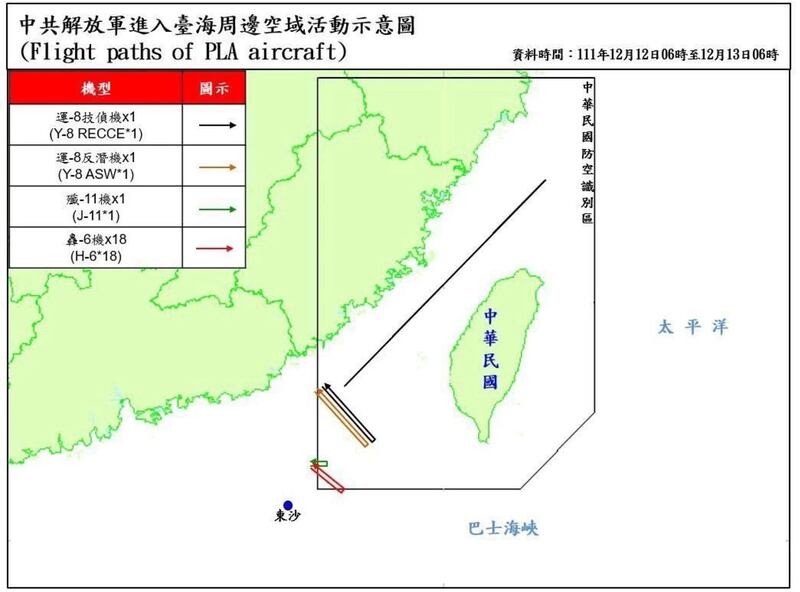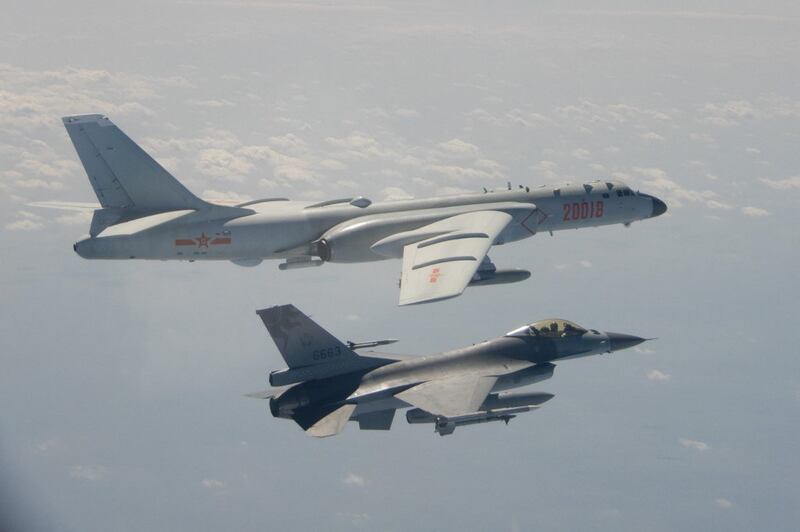China has sent a record number of nuclear-capable strategic bombers into Taiwan’s air defense identification zone in what analysts say could be a warning against “foreign support” to the island.
The Ministry of National Defense in Taipei said that over 24 hours from Monday to Tuesday, China sent 21 aircraft, including 18 Xian H-6 strategic bombers, into the southwest of Taiwan’s ADIZ. A further eight military aircraft and three warships were also spotted around the island.
An ADIZ is an area where foreign aircraft are tracked and identified before they reach a country’s airspace.
This is the largest number of the bombers seen entering Taiwan’s ADIZ in a single day so far.
According to the flightpath provided by the defense ministry, Beijing also dispatched a Y-8 anti-submarine aircraft, a Y-8 tactical reconnaissance aircraft and a J-11 fighter to the area.

“By sending more and more strategic bombers with anti-access and area denial capabilities, China could be delivering a message that they are able to deny any foreign support to Taiwan,” said Jyh-Shyang Sheu, a military expert at Taiwan's Institute for National Defence and Security Research (INDSR).
The move comes just as a senior member of Japan's Liberal Democratic Party completes his visit to Taipei. Koichi Hagiuda became the first LDP policy chief to visit Taiwan in nearly 20 years.
Hagiuda, who is known to have been close to former Prime Minister Shinzo Abe, met with Taiwanese President Tsai Ing-wen and called for a deepening in cooperation between the two sides amid China's growing military and economic coercion against Taiwan.
Also on Monday, the LDP and its coalition partner, Komeito, reached an agreement to label China an unprecedented "strategic challenge" in Japan’s new national security strategy.
Deterring ‘foreign reinforcement’
China has been increasing pressure on the democratic, self-ruled island that Beijing considers a breakaway province that should be reunited with the mainland.
Just several days ago, China banned a number of Taiwanese imports including seafood, brewing and distillery items.
Chinese aircraft incursions into Taiwan’s ADIZ have occurred on a daily basis since the visit by U.S. House of Representatives Speaker Nancy Pelosi to Taipei in August. At the time of the visit, China held week-long military exercises at six locations around Taiwan.
These regular air sorties serve as a “rehearsal for a future combat scenario, perhaps a blockade of the main island and at the same time an attack on one of the outlying islands of Taiwan,” said a defense expert who wished to remain anonymous because they are not authorized to speak to the media.

The latest H-6 bomber incursions took place near the Pratas islands in the South China Sea, which are administered by Taiwan but also claimed by China.
The H-6 long-distance bomber is a copy of the old Russian Tu-16 “Badger” bomber and is “long known to have nuclear capabilities,” according to Jyh-Shyang Sheu from INDSR.
“However it seems that in the new H-6 versions they cancel the internal bomber bays but instead include stand-off weapons (SOWs), mainly cruise missiles,” Sheu said.
“The purposes are likely to extend the range and focus on carrying the SOWs that could be used to attack Taiwanese military targets but most importantly to deny foreign reinforcement, such as from U.S. aircraft carriers,” the Taipei-based analyst added.
During the Zhuhai Airshow in November, the Chinese Air Force put on display a new H-6K bomber which reportedly carried advanced hypersonic missiles.
These air-launched missiles are believed to be designed to precisely hit and destroy stationary and slow-moving targets such as aircraft carriers.
